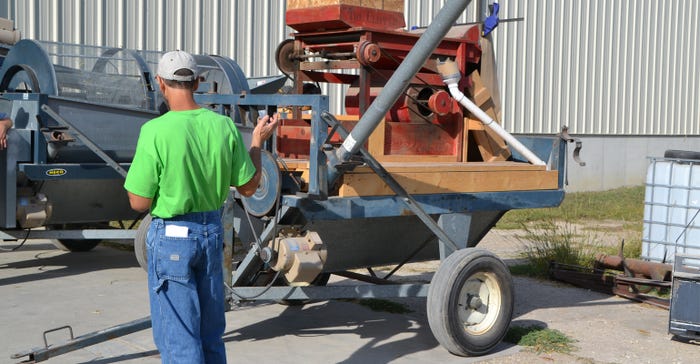October 19, 2017

The Canfield family hosted a field day in September on their farm near Dunkerton in northeast Iowa. A few years ago, they decided to make a big change on their farm: shifting from producing conventional corn and soybeans for the commodity market to raising non-GMO corn and soybeans along with oats and hay. They started an on-farm feed business and now direct-market much of what they raise through the business.
"The way we're farming now, it's wonderful for our family. When we were just raising corn and soybeans, the opportunities for our kids to get involved was very limited," Earl Canfield says. Now, the kids are all directly involved with the day-to-day operations of the business. "We are trying to create some new, viable business opportunities for my children and grandchildren and however many generations we are privileged to have on this land."
He adds, "I feel better about farming now than I have ever before in my life, doing what we're doing now. And of course, a lot of this isn’t really new. In my grandfather's generation, what you see here was really common on farms all over Iowa."
Canfield says he believes if there was more diversity on the landscape, everyone would benefit: "If more farmers could find a way to do this type of thing all over Iowa and the Midwest, it could open up a new way of doing business that would benefit everybody. You could have farms everywhere with a healthy mix of crops growing that’s better for the land, water, air and better for the economy.”
For people like him to be successful, Canfield thinks farmers need to get better at talking with consumers. "We need customers,” he says. “And we need farmers who are willing to talk to and engage those customers. We do that always on our farm, and the rewards are big."
"Three years ago, if you looked at the equipment lineup on our farm, it was all geared at producing corn and soybeans," he says. "All the equipment we owned, that's all it was good for, just raising row crops." One of the barriers to adding small grains and hay to a row crop operation is finding equipment. You can find big equipment, and that works if you have a larger operation, but this family farms around 300 acres, and has around 40 acres of oats in any given year.
A swather is a good example. "It’s a good tool to have, but they're hard to find. Maybe if enough farmers start raising small grains in Iowa, that will change,” he notes. He’s spent hours on Craig’s List and on the road, finding the right equipment.
One thing about small grains is they spread out the workload. "It's nice going into fall, that the entire farm doesn't have to be combined between first of October and first of November,” says Canfield. “It spreads the planting load out, too, as you're planting a month or more before corn and soybeans; both mean you can get by with a smaller planter and a smaller combine. It makes life a little easier, less stressful," he says.
Don’t have to buy a lot of new equipment
While there is some new equipment that's helpful to have, other equipment just requires you to know how to use it in a different way. "Other than getting [a pickup] head, I didn't have to do anything different to this combine. All the settings for harvesting small grains are in the operating manual," he says. "We learned how to use it."
 A MARKET: Earl Canfield shows visitors an old Clipper cleaner his sons modified to increase the capacity for cleaning grain for their feed business. With nowhere to go with the oat crop they began producing a few years ago, the Canfields started mixing oats to make feed for cattle, horse and other small livestock producers.
A MARKET: Earl Canfield shows visitors an old Clipper cleaner his sons modified to increase the capacity for cleaning grain for their feed business. With nowhere to go with the oat crop they began producing a few years ago, the Canfields started mixing oats to make feed for cattle, horse and other small livestock producers.

Of course, there are lessons. Canfield has a 1992 John Deere 9400, a conventional combine with a cylinder and beater. "That first year we were plugging up something fierce. First time it happened, it killed the combine instantly," he says.
They realized the separator was plugged, and Earl looked in the operator's manual to see how they could stop that. "Turns out there are two positions for that beater. You can drop the beater down and open the throat up a little more. It might plug once in a while, but you can always get the plug out without opening the combine up and getting the plug out by hand."
Last year, the Canfields began selling bagged oats and corn after struggling to sell their oats on the commodity market. One thing led to another. After adding a farm website and a hodgepodge of used cleaning, grinding, weighing and bagging equipment, and meeting a lot of new people, the Canfields have an on-farm feed business.
They don't do medicated feed or use preservatives, so they are making all "mill to order" feeds. "We don't grind feed and let it sit on the shelf for six months; we work with people," he says. It's less of a hassle, and a more natural product. A "marriage of non-GMO grains and organic supplements," as Canfield calls it, is what their customers want. He says the business is growing, and there's a lot more out there if they can expand production capabilities.
Because the feed isn't organic, the Canfields can offer it for a bit cheaper than organic feed. But because it's locally grown and uses organic supplements, they can charge a premium. "We've got enough customers who come back to us even if we're not the cheapest feed in town. They know we're trying to produce a good-quality product, and they're willing to pay for that," he adds.
Making direct farm marketing work
Jane Canfield says if you want to make direct marketing work, you must be willing to invest time and effort into its success. "The marketing part of it is huge; it's a lot of work. If you're not good at, find someone who is that can help you," she says. Jane handles all of the branding and design for the farm — business cards, website, fliers, etc., but doesn't like to spend a lot of time talking on the phone. "So it works out well that he does," Jane says about Earl. He adds, "I couldn't do any of this without my family. This is a team effort. I'm very blessed."
Learn more about the Canfields on their website canfieldfamilyfarm.com. Also, you can check out these videos about the family’s farm on YouTube:
• Canfield Family Farm — Why they diversified
• Canfield Family Farm — Equipment for oat and hay production
• Canfield Family Farm — Direct-marketing and on-farm feed business
To hear more from Earl Canfield, check out PFI’s YouTube series Rotationally Raised, introduced earlier this year. The series shows why more farmers are looking at diversifying their crop rotations and how to get the process started.
Ohde writes for Practical Farmers of Iowa in Ames.
About the Author(s)
You May Also Like






